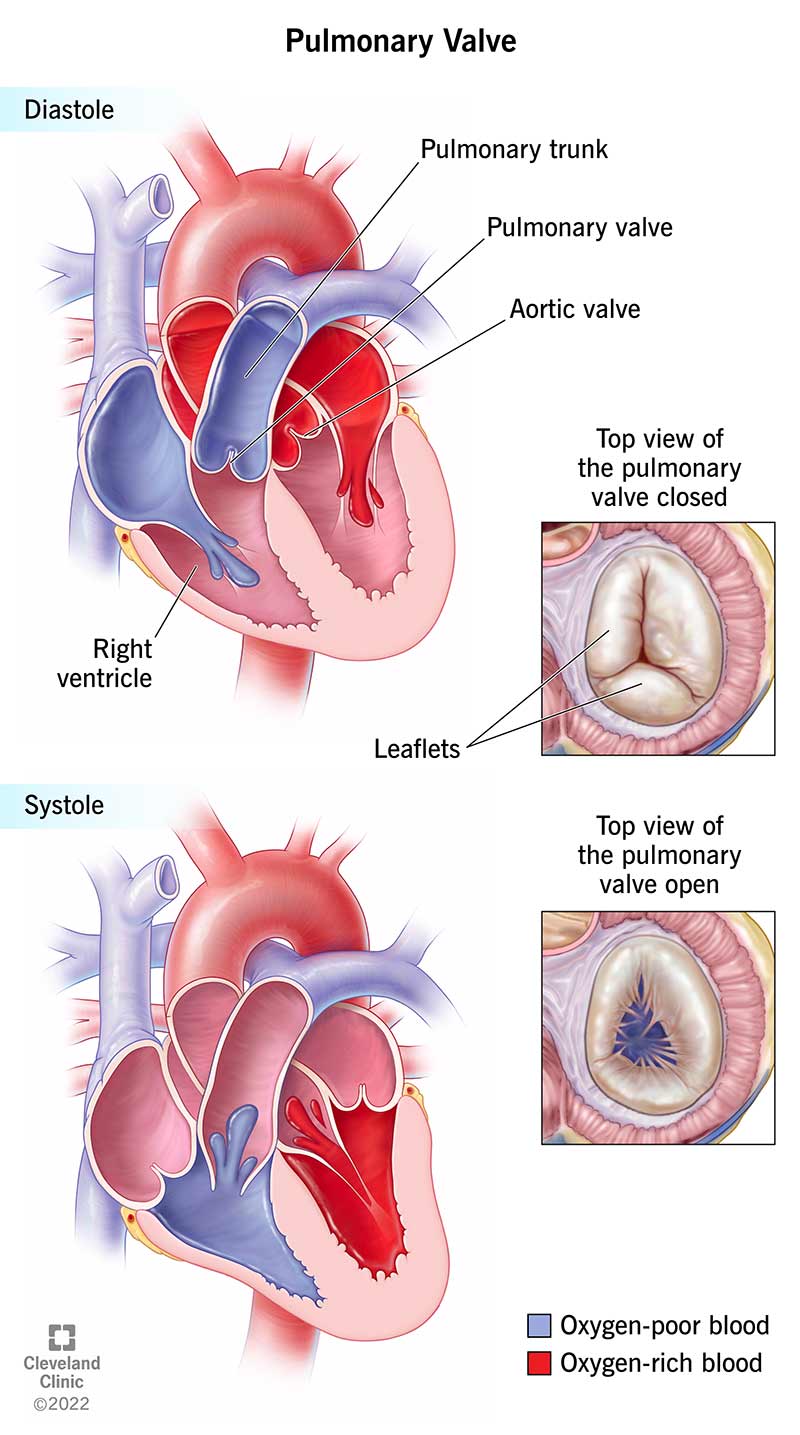Your pulmonary valve manages blood flow from your heart’s right ventricle to your pulmonary trunk. Its main function is to help oxygen-poor blood reach your lungs, where it gains oxygen and gets rid of carbon dioxide. Your pulmonary valve has three leaflets that open and close to start and stop blood flow toward your lungs with each heartbeat.
Advertisement
Cleveland Clinic is a non-profit academic medical center. Advertising on our site helps support our mission. We do not endorse non-Cleveland Clinic products or services. Policy
Your pulmonary valve is a heart valve that helps manage blood flow in your heart. Your pulmonary valve controls the flow of oxygen-poor blood from your heart to your lungs. You can think of this valve as the “door” between your right ventricle (lower right heart chamber) and your main pulmonary artery (also called your pulmonary trunk). Once your blood enters your main pulmonary artery, it travels through your left and right pulmonary arteries into your lungs.
Advertisement
Cleveland Clinic is a non-profit academic medical center. Advertising on our site helps support our mission. We do not endorse non-Cleveland Clinic products or services. Policy
Your pulmonary valve and your aortic valve are the two semilunar valves of your heart. They have this name because their leaflets (flaps) look a bit like crescent moons. Semilunar valves are the passageways between your heart’s ventricles (lower chambers) and arteries.
Pulmonic valve is another name for your pulmonary valve. You may see that term when reading about the anatomy of your heart and lungs.
The main function of your pulmonary valve is managing the flow of oxygen-poor blood from your right ventricle into your main pulmonary artery. Here are some key points to know:
Besides controlling blood flow out of your heart, your pulmonary valve can take on another role. It can serve as a replacement for your aortic valve when it’s become too diseased to function properly.
The Ross procedure is a surgery that helps some children and adults (under age 60) with aortic valve disease. During this complex procedure, a surgeon removes your aortic valve and replaces it with your pulmonary valve. They then give you a donor pulmonary valve. Your native pulmonary valve serves as a durable replacement for your aortic valve because it has similar anatomy and function.
Advertisement

Your pulmonary valve closes when your heart relaxes (diastole) and opens when your heart contracts (systole), managing blood flow from your right ventricle to your pulmonary trunk.
Your pulmonary valve is located inside your heart. It connects your right ventricle with your pulmonary artery. It’s situated to the right of your aortic valve, and just in front of it.
Your pulmonary valve has three leaflets (also called cusps or flaps) that open and close to control blood flow. These are your anterior cusp, left cusp and right cusp. The cusps attach to a tough, fibrous ring of connective tissue called the annulus. The cusps are just the right size to completely close the valve in the diastolic phase. This prevents backflow, also called regurgitation, of blood into your right ventricle.
Pulmonary valve disease can take many forms. Most pulmonary valve problems are congenital heart conditions, meaning you or your baby has them at birth. Less often, pulmonary valve issues develop later in life. This is usually due to other medical conditions like pulmonary hypertension.
Conditions that may affect your pulmonary valve include:
Your pulmonary valve plays a vital role in sending blood to your lungs to receive oxygen. You need a properly working valve to stay alive. Babies and children who don’t receive treatment for serious pulmonary valve conditions have a shortened life. It’s important to talk to your healthcare provider or your child’s provider about treatment options for pulmonary valve disease and life expectancy.
You can’t always prevent heart valve problems. But in general, a heart-healthy lifestyle can help keep your valves and heart working at their best. Tips include:
Learning the anatomy of your heart can feel overwhelming. This is especially true if you or your child has been diagnosed with a heart problem. There’s a lot of information to take in. It’s not always easy to remember which valve leads where, or how a certain condition affects blood flow. But keep in mind that your healthcare provider is there to offer support and resources as you continue learning. Don’t hesitate to ask any questions that come to mind.
Advertisement
Pulmonary valve disease may come as a shock. At Cleveland Clinic, you’re in the most capable hands. We’re ready to help you journey to a healthy heart.

Last reviewed on 10/10/2022.
Learn more about the Health Library and our editorial process.